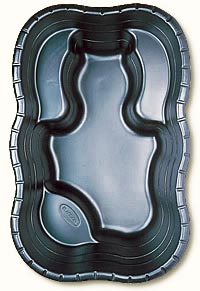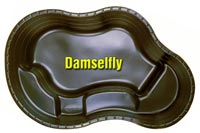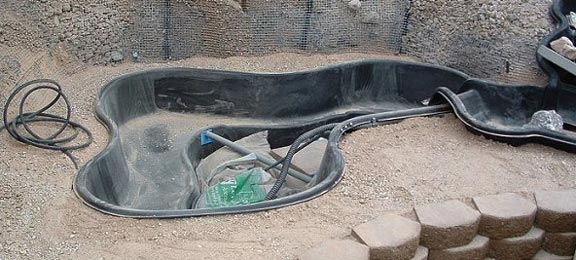CHOOSING AND INSTALLING PREFORMED PLASTIC PONDS
Preformed plastic ponds are often a popular choice among new pond builders vs. traditional flexible liners. When used with the right motivation, a pond builder can create a successful pond using a preformed liner. However, it is important to note up front that there are limitations to the preformed approach, and it is important to be aware of these before choosing a liner for your pond.
We recommend our custom made, flexible preformed pond liners over traditional hard plastic liners:
Advantages of Preformed Ponds
The main advantage of a preformed plastic pond is that they fold up for easy transport, yet spring in to shape quickly and easily when unpacked. When purchasing, there are numerous shapes and sizes available and installation is quite straightforward as long as you remember a few important tips. Please see the section on installation below for more information.


Known Disadvantages
There are however some disadvantages to preformed plastic ponds over traditional liners, or other types of preformed options. The main disadvantage is that preformed ponds are usually quite small and shallow compared to custom-built liner ponds. The smaller size can have repercussions later including:
- It's more difficult to create a proper ecological balance in a small pond, which can lead to poor water quality.
- Shallow water is more prone to overheating which creates problems for fish and promotes pesky algae growth.
- It's usually not possible to keep traditional pond goldfish and koi due to the shallow depth and small size.
- There's not as much room for things like waterfalls, plants and aquarium fish without overcrowding.
- We have heard reports that some brands are prone to cracking.
Keeping the above in mind, preformed liners aren't all bad. If your main goal is just to create a small pond in your backyard to plant some water lilies, or to add a small focal point to your garden without a lot of expense or work, then a preformed plastic pond will likely work fine. In fact, if going with this approach, instead of adding a pump and filter to keep your water clean, you would probably be fine just adding some floating oxygenating plants and other plant life to filter the water naturally. For more information on pond plants, please see our page on pond plants.
On the flip side, if you plan on adding a large waterfall and lots of fish that will require pumps and filters, you may want to consider building a more advanced pond out of a flexible pond liner to get a little extra depth, size and flexibility with regards to design. If you still want the convenience of a preformed shape and no folds in the liner, then maybe a box-welded liner is right for you. A box-welded liner is made by heat welding flat liner panels into a 3D 'box'. To learn more please see the image on the right or the box-welded polypropylene liners in our store.
Installing Preformed Plastic Ponds
The first thing to do is have a look at the instructions included with the pond to read any startup procedures that might be required. For instance, it is usually a good idea to rinse the pond out before installing it into the ground incase there are any chemicals left over from the manufacturing process.

Important Considerations
The most important thing to remember when installing any preformed pond is to make sure the pond is level. A good way to accomplish this is to dig your hole a little deeper and wider than you need by about 4 to 6 inches all around, and then fill the bottom with sand to create a level base. Use a level to make sure the pond is level from end to end and from side to side. A sand base will also help prevent any sharp rocks from puncturing the base of the pond when water is added. After the base is level, place the preformed liner into the hole and backfill around the edges with more sand, compacting periodically. Make sure the pond is tight and secure in the ground with no rocking or movement before adding water.
Other Types of Liners Available
For more general information on other types of pond liners, including flexible liners, please visit our page on Pond Liners.
Have liner questions? Visit our FAQ page
